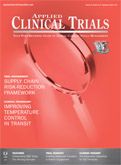FDA Moves to Broaden Acceptance of Real-World Evidence in Clinical Research
Applied Clinical Trials
New legislation aims to expand regulatory acceptance of patient data from healthcare systems and observational studies.
The 21st Century Cures Act and the newly authorized prescription drug user fee agreement both aim to expand FDA acceptance of patient data from healthcare systems and observational studies in regulatory decision making. FDA, consequently, is working with stakeholders to better define and clarify the nature and sources of such real-world evidence (RWE) and how it differs, and converges with, information obtained from randomized controlled trials (RCTs). The aim is to use data from health plans and registries to answer questions about treatment effects and outcomes for broader patient populations than possible in a specialized research environment, and, in the process, to streamline clinical development and inform the safe and effective use of medical products.
The Cures Act supports FDA use of RWE to evaluate additional indications to an approved therapy and safety and effectiveness after a product comes to market. Notably, the legislation stops short of mandating FDA consideration of this evidence in assessing new medical products, as sought by some reformers; FDA retains authority to require RCTs for product approval and postapproval studies. To implement the RWE policy, FDA has two years to develop a framework for assessing information sources and to set standards and methodologies for data collection and analysis.
Similar initiatives for advancing the use of RWE in FDA policies and approval decisions are included in the goals letter implemented by the latest version of the Prescription Drug User Fee Act (PDUFA VI). The program seeks to expand the capacity of FDA’s Sentinel Initiative to help assess drug efficacy as well as safety. FDA will hold public workshops and propose pilot studies or methodology projects to address concerns and challenges related to RWE use, and additional guidance will clarify the use of such evidence to support decisions on supplemental indications and postmarketing commitments.
A preview of how FDA may address these issues can be seen in a final guidance published August 30 on the use of RWE to support regulatory decisions for medical devices. The document finalizes a draft guidance issued in July 2016 and aims to encourage the development and use of evidence gleaned from actual product use to help bring new devices to market faster and based on more reliable information.
Janet Woodcock, director of the Center for Drug Evaluation and Research (CDER), and CDER colleagues anticipate that broader use of “big data” from electronic health records, claims data bases, social media, and “smart” devices can support and streamline the current clinical development process. Writing in the Journal of the American Medical Association (JAMA, 2017; 318(8); 708-709), the authors explain how RWE may facilitate clinical research by aiding in trial design, study site selection, external control group formation, and study enrichment. While FDA has utilized RWE primarily to assess drug safety issues, Woodcock and staff envision that it such information will be useful in evaluating drugs for rare diseases where a randomized study is not feasible, in developing natural histories of certain diseases, in devising optimal dosing regimens, and in assessing longer-term outcomes unknown at time of new drug approval.
Experts weigh in
In its Work Plan for implementing Cures issued in June, FDA outlines its intent to develop the framework for evaluating potential uses of RWE. FDA launched the project at a public workshop Sept. 13, where participants discussed the definition of real-world “data” (RWD)- information related to routine health delivery -vs. real-world “evidence” that addresses the benefits or risks of a drug derived from RWD analysis. Presentations focused on challenges involved in RWD collection and quality, innovative methods for developing RWE from RWD, and promising areas for RWE pilot demonstrations.
To encourage broader consideration of these issues by the medical community, an FDA collaborative center led by Yale University and the Mayo Clinic outlined approaches for combining evidence from observational studies and RCTs in a recent webinar on utilizing RWE “beyond randomized controlled trials.”
FDA also has engaged the National Academies of Sciences, Engineering, and Medicine (NASEM) Forum on Drug Discovery, Development, and Translation to host three workshops on the impact of RWE on medical product development and on health product payment and delivery. The first session Sept. 19-20 addressed incentives for collecting and using RWE and gaps in data generation. FDA officials and experts from industry, academia, healthcare systems, and patient organizations examined the value of RWE in research studies, potential for using Sentinel to evaluate product effectiveness and efficacy, how registries can provide RWE, and the prospect that greater use of RWE may provide more reliable and precise evidence than traditional clinical research. Future meetings in 2018 will explore strategies for improving RWD collection and matching the “right data to the right questions.”

FDA Fast Tracks Johnson & Johnson’s Nipocalimab for Fetal Neonatal Alloimmune Thrombocytopenia
March 27th 2024Johnson & Johnson is moving forward with a pair of Phase III trials of nipocalimab to reduce the risk of fetal neonatal alloimmune thrombocytopenia in alloimmunized pregnant patients.